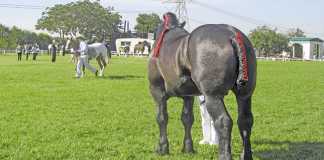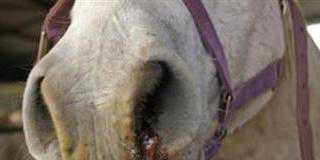
Cushing’s syndrome is often thought of as a disease that only afflicts older horses. However, it’s been known to occur in horses as young as eight. A horse with Cushing’s syndrome – or hyperadrenocorticism – can be easily recognised by its coarse, wavy coat. It will also appear to have a pot-belly and a ‘sway-backed’ look. Mares tend to be infertile and lethargic.
Other symptoms include excessive thirst, combined with excessive urination. A horse will normally drink about 30l a day. A horse suffering from Cushing’s will drink almost double that. Cushing’s syndrome also makes horses more prone to infection, laminitis and other diseases, as their immune systems have been compromised.
Cause
The disease is caused by a tumour of the pituitary gland. This is the small gland at the base of the brain which regulates the horse’s endocrine system. As the tumour grows, it puts pressure on the nearby hypothalamus, which regulates the body’s temperature. This is believed to be the primary cause of the distinctive coarse coat. Cells in the pituitary gland become overactive and the entire endocrine system is knocked out of balance. Cortisol levels and insulin resistance increase, while thyroid hormone levels decrease.
Even though the symptoms are often very obvious, a number of tests have been developed over the years to positively diagnose Cushing’s syndrome in horses. The Overnight Dexamethasone Suppression Test is currently considered to be the best and only involves two blood samples. The first is taken in the late afternoon, and the drug Dexamethasone (a synthetic form of cortisol) is given immediately thereafter. The second blood sample is taken between 8am and midday the following day.
Treatment
Treatment involves a form of hormonal replacement therapy. The most effective drug at the moment is Pergolide Mesylate. This Parkinson’s medication stimulates the production of the missing hormone dopamine, which controls the affected part of the pituitary gland.
Horses are initially assessed every two to four weeks to ensure the dose is correct – that is, it is high enough to start hair shedding, muscle and weight gain and improvement in demeanour. The drug controls the hormones that the tumour makes. It doesn’t have any effect on the size of the tumour, nor does it stop it from growing. Horses with mild Cushing’s disease, then, may be returned to good health for a number of years – but eventually euthanasia will become the kindest option.
Diet
A full dosage of Pergolide should be given in summer and autumn and half the dosage in winter and spring. With your vet’s recommendation you can add 4g Levothyroxine Sodium every day. This will help maintain thyroid function. In addition, the horse needs regular de-worming, teeth checks, shoeing every six to eight weeks, and its vaccinations must be kept up to date.
Furthermore, because of the risk of laminitis, its diet has to be monitored, and pellets that have been heat processed or steam extruded instead of grain mixes should be used. These are digested completely in the small intestine, unlike grain, which is incompletely digested in the small intestine and, if large amounts reach the large bowel, can cause laminitis. Good quality lucerne chaff and hay can provide the protein required as long as it isn’t too lush.
Supplements
High quality vitamin supplements are also needed. Food-source vitamin and mineral supplements include: blue-green algae, kelp, apple cider vinegar, carrots and oranges. Essential fatty acids will help make the cell wall more sensitive to insulin, while flax and hemp oil will provide omega 3 fatty acids palatable to the horse.
Horses suffering from Cushing’s can lead very happy and active lives. There are reports of ponies returning to the show ring, recovering from laminitis and being pain-free, and living in retirement, working and successfully breeding again quite happily.
Contact Kim Dyson on 082 888 6511 or at [email protected]. Please state ‘Horse therapy’ in the subject line of your email.













